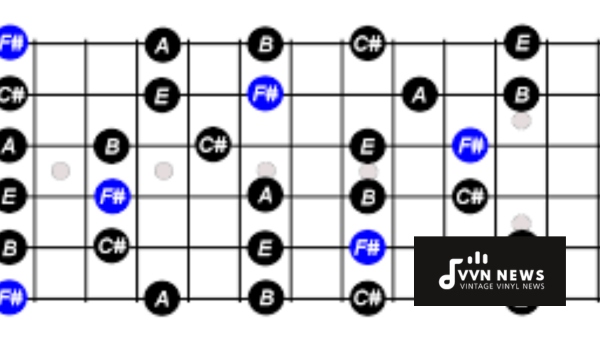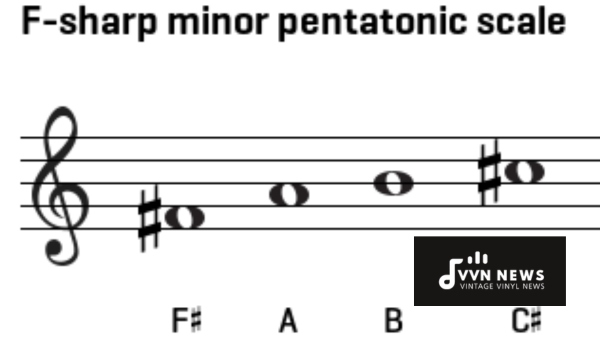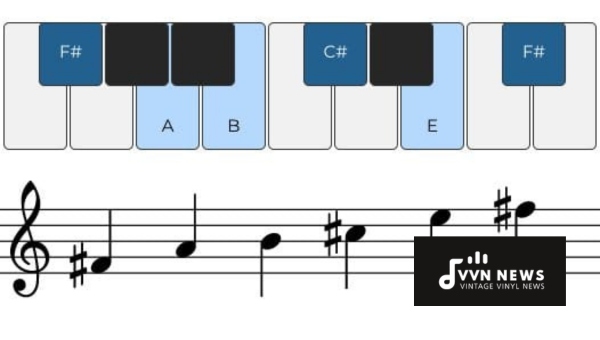As an avid musician, I often find myself drawn to the enchanting symphony of scales, and the F Sharp Minor Pentatonic scale is no exception.
Its unique combination of notes creates a harmonious sequence that can carry listeners to another world.
This scale, like others, has the power to evoke a wide range of emotions; leaving one minute in introspective solitude and the next in exhilarating energy.
In the realm of music theory, this fascinating scale offers immense potential for creativity and expression.
Whether you’re just discovering the wonders of music or you’re an experienced composer seeking new inspiration, your artistic journey would be notably enriched by mastering the F Sharp Minor Pentatonic scale.
Let’s embark on a voyage through its harmonic landscape to unfold its captivating tonal beauty and profound musicality.
What is the F Sharp Minor Pentatonic Scale?
The F Sharp Minor Pentatonic scale is a remarkable tool in the arsenal of many musicians.
Formed from five notes, hence, pentatonic, this scale consists of the pitches F#, A, B, C#, and E.
Its unique tonality shines through in Blues and Rock genres, but it indeed holds the universal charm.
With its first note being an F# (also the ‘root’), it lends a distinct character to your musical expression.
The recurring pattern in this scale adds up to its alluring complexity; however, with practice and focus, it proves accessible and boundlessly rewarding for any musician – beginner or seasoned.
Guide to Constructing the F Sharp Minor Pentatonic Scale

The F Sharp Minor Pentatonic scale is not just a combination of random notes; it follows a specific structure that dictates its distinctive sound.
The framework is based on intervals, the distance from one note to its next partner in the scale.
To create the F Sharp minor pentatonic scale, you start with the root note—F#. Following that, you’ll include these steps:
- Root: F#
- Minor Third: A
- Perfect Fourth: B
- Perfect Fifth: C#
- Minor Seventh: E
These indispensable notes form our desired scale: F# – A – B – C# – E. The interplay between these tones gives the F Sharp Minor Pentatonic scale its haunting beauty and inherent tension.
An integral point to remember is that there are no half-steps in this scale; it comprises of whole and one and a half steps, providing it with a bluesy, exotic feel that musicians of every genre love.
Embrace each note’s role within the sequence; appreciate their contributions as you meld them into powerful melodies and vibrant harmonies.
As you familiarize yourself with these patterns and characteristics, crafting music using this scale will grow more intuitive and enjoyable.
Also Read: A Minor Pentatonic Scale [Create Powerful Solos With This Key]
Five Positions of F Sharp Minor Pentatonic Scale on the Guitar
Let’s dive into the heart of the matter, exploring the five unique shapes of the F Sharp Minor Pentatonic scale on guitar.
It’s all about your fingertips moving across the fretboard in a well-choreographed dance.
1. Position One
Starting with the first position, let’s imagine our guitar’s fretboard. A classic position is when your index finger is placed on F# (the root note), which lies on the second fret of the low E string.
Next, guide your fingers through a diagram of notes across the fretboard:
- 2nd-5th frets on the E (lowest) string
- 2nd-4th frets on the A string
- 2nd-4th frets on the D string
- 2nd-4th fret understand
- 2nd-5th frets on the B string
- 2nd-5th frets once more, but on a high E (topmost) string
This position often serves as the basis for other shapes.
2. Position Two
Shifting to our second shape encompasses notes from these specified areas:
- 5th to 7th-fret range on both E strings
- Again in the same range (5th to 7th-fret), but moving onto A and D strings,
- On G and B strings, stretch slightly further from the 4th to 7th fret.
This shape allows you to explore a higher pitch within the scale.
3. Position Three
Our third plate highlights more of those middle-pitch tones:
- 7th-9th fret stretch for both E strings and A string
- Following next comes a slide back into the 6th to 9th-fret span, which is none other than D and G strings.
- Lastly, again in this zone (7-9) our B string
Make sure to practice this unique shift in movement between strings.
4. Position Four
Illustrating our fourth shape presents an interesting dynamic movement along with some distinct low and high notes:
- 9th-12th-fret surface broads both strings E and A
- D string accommodates an 8-11-fret span
- Next two, G and B strings, again find the zone 9-12-fret
Wrapping up with our high E string, which dwells on 9 to 12 frets
5. Position Five
Our final shape takes us into the upper echelons of the fretboard:
- Both E string reflects notes in position 12-14-fret
- The A-string operates in the range – 11 to 14-fret range
- D, G, and B strings cover 11 to 14 frets
- Lastly, the higher end of A is voiced out by touching high E strings on 12-14-free.
These five positions work together harmoniously to give you a full spectrum of sound within the F Sharp Minor Pentatonic scale.
As you journey through these positions, remember it’s not about speed but mastering tone quality and pacing.
Also Read: C Sharp Minor Chords [Simple Guide For Aspiring Musicians]
Major and Minor Variations of the F Sharp Pentatonic Scale

The F Sharp Pentatonic Scale manifests in two distinct versions – the Major and the Minor.
Each version brings out a unique sonic palate, thereby cultivating a specific mood or feeling to your music.
Major Scale
The F Sharp Major Pentatonic Scale follows a specific pattern: F# – A# – B – C# – E#, leaving out the fourth and seventh notes from the Major scale.
An uplifting, joyful resonance is eminent in this variation, making it highly sought-after in various genres such as Pop, Country, Blues, and Rock.
Minor Scale
Meanwhile, the F Sharp Minor Pentatonic scale, characterized by a darker tone, follows the formation: F# – A – B – C# – E.
The pattern illuminates individual emotions by capturing somber moods which adds depth to various forms of music like Blues, Metal, Jazz, and Rock.
Practical knowledge of both scales is instrumental for musicians aspiring to diversify their musical prowess.
It can aid you in creating eclectic melodies remarkably suitable for improvisation and songwriting.
Notably vibrant solos are often accomplished with these two variations of pentatonic scales.
Effective Practice Methods with Tracks for F Sharp Minor Pentatonic Scale
In the pursuit of perfecting the F Sharp Minor Pentatonic scale, incorporating tracks into your practice routine can dramatically enhance your sonic journey.
Here are some strategies to help you incorporate backing tracks and streamline your practice sessions effectively.
Find Backing Tracks Online
There are numerous online resources available that offer backing tracks in various keys. Websites such as JamPlay provide a vast collection of music scores.
Listen, Connect, and Experiment
Begin by immersing yourself fully in the rhythm and tempo of the backing track.
Feel the pulse of the beat pulse through you. As you resonate with it, start experimenting by playing the notes in sequence.
Vary Your Tempo
Play along with tracks at varying speeds. This not only strengthens muscle memory but also enhances your adaptability to different tempos.
Initially, aim to play slowly and gradually increase the speed as you become comfortable.
Create Your Own Melodies
Once you gain confidence playing along with existing tracks, chin up and let your creativity fly!
Begin crafting melodies derived from F Sharp Minor Pentatonic scale on these tracks. Remember, there’s no right or wrong, just endless possibilities.
Practice Regularly
Consistency is key in achieving mastery over any musical scale. Have a set practice time each day to hone your skills on this delightful scale.
Everyone’s approach to practicing is different; however, always try to ensure that practicing is an enjoyable process rather than a task.
This sense of enjoyment encourages ongoing learning while promoting creativity and expression within music creation.
Also Read: G Sharp Minor Chords [Guitarist’s Guide]
What is the role of ear training in mastering the F Sharp Minor Pentatonic Scale?

When we dive into the depth of the F Sharp Minor Pentatonic Scale, we chip away at the vast iceberg that is music theory.
But music isn’t merely confined to charts, intervals, and scales—a crucial part of making music lies in being able to hear, comprehend and apply these abstract concepts. That’s where ear training comes into play.
Recognition of Intervals
In the wilderness of notes that make up a scale, it’s easy to get lost without a clear sense of direction.
Each interval, or distance between two notes, carries its own unique sound and emotional color.
Being able to identify these intervals by ear can greatly aid your navigation through the F Sharp Minor Pentatonic Scale.
Improving Improvisation Skills
From fiery solos to soothing melodies lined with soulful phrases—the art of improvisation breathes life into your performance with the F Sharp Minor Pentatonic scale.
With consistent ear training exercises, you can significantly enhance your ability to spontaneously create melodies that resonate with your listeners on a profound level.
Harmonic Analysis
Uncovering the harmonies hidden within this enigmatic scale requires more than just acknowledgment of written notes—it demands an attentive ear that can perceive subtle changes in harmony and pitch relationships within this scale.
Compositional Awareness
The structure behind this beguiling scale equips you with a more refined compositional voice—one that interprets mental ideas into musical narratives, seamlessly bridging thoughts and sounds.
Building Intuition
Well, training your ears can actualize this dream! It strengthens intuitive musicianship skills, which enable you to translate melodies conceived in your mind into an instrument effortlessly.
While learning about scales like the F Sharp Minor Pentatonic brings intellectual enrichment, integrating ear training into your practice routine ensures holistic musical growth.
Each chord struck, every note played, resonates deeper when you allow your intellect and auditory senses to join hands.
A rigorous drill of your listening skills may lay the groundwork for an intimate dialogue between you and your instrument—one that echoes the harmony existing in the universe outside and within us.
Also Read: F Sharp Minor Chords [Music Theory Demystified]
Songs Incorporating the F Sharp Minor Pentatonic Scale
Exploring songs incorporating the F Sharp Minor Pentatonic scale can significantly enhance your appreciation for music and help you grasp practical applications of this scale.
Let’s review five diverse songs that leverage this harmonic spectrum to compose their enchanting melodies.
“Black Magic Woman” by Santana
Black Magic Woman by Santana skillfully demonstrates the passionate voice of the F Sharp Minor Pentatonic scale.
This song’s transfixing guitar solo comes alive in the F Sharp Minor Pentatonic scale, resonating with an unforgettable electric blues feel.
“You Give Love a Bad Name” by Bon Jovi
This hard-hitting anthem by Bon Jovi relies on the emotive power of the F Sharp Minor Pentatonic scale throughout its verses and chorus.
The song’s memorable riffs are textbook examples of how to implement this soul-stirring scale effectively.
“Sweet Child o’ Mine” by Guns N’ Roses
Despite Sweet Child o’ Mine being played using different scales, certain segments undoubtedly use elements of this versatile scale.
Most notably, some sections of Slash’s solos employ motifs spun from the F sharp minor pentatonic mold.
“Purple Rain” by Prince
Prince creates an achingly beautiful landscape of sound with Purple Rain, painting melodic structures heavily inspired by our focal scale.
This emotionally charged composition exemplifies how a minor pentatonic can project profound sentimentality in music.
“Comfortably Numb” by Pink Floyd
David Gilmour’s poignant solos in Comfortably Numb extract expressive depth from various scales, including the F Sharp Minor Pentatonic at chosen moments.
The track strikingly exemplifies how to weave different scales within a single piece seamlessly.
These highlighted songs using the F Sharp Minor Pentatonic Scale can act as your beacon of inspiration.
The versatility of this scale beckons you towards endless avenues of creative exploration.
Arm yourself with this knowledge, let your fingers dance on the keys, and bring forth music that echoes your unique voice.
Also Read: A Sharp Diminished Triad [Discover This Unique Chord]
FAQs About the F Sharp Minor Pentatico Scale
What is the essence of the F Sharp Minor Pentatonic Scale?
The F Sharp Minor Pentatonic Scale is a five-note scale, consisting of the pitches F#, A, B, C#, and E. Its unique patterns and sound make it a favored choice in many music genres.
How versatile is the F Sharp Minor Pentatonic Scale?
It’s quite versatile. Melding seamlessly into blues, rock, pop, and jazz music, this scale delivers nuanced depth and a touch of edge to any composition.
Is it difficult to learn the F Sharp Minor Pentatonic Scale on guitar?
Not at all. With practice and familiarity with guitar fretboard patterns, mastering this scale becomes accessible over time.
Can ear training aid in playing the F Sharp Minor Pentatico Scale more fluently?
Yes, ear training sharpens your listening skills and enhances your musical instinct. This can vastly improve your playing fluidity with this scale.
Are there popular songs that use the F Sharp Minor Pentatonic scale?
Many artists incorporate this scale in their compositions. One iconic song that stands as an example is “Stairway To Heaven” by Led Zeppelin.
Conclusion
The journey through the F Sharp Minor Pentatonic scale has indeed been enlightening.
With its rich sound and versatile use, this scale will indefinitely enhance your musical expression.
May you find solace and excitement as you explore this beautiful melody on your own.
Remember, practice is paramount in mastering any scale. Also, ear training is a powerful tool that can greatly improve your musical intuition.
Take everything we have discussed to heart, and soon you might be composing music imbued with the magical echo of the F Sharp Minor Pentatonic Scale.








